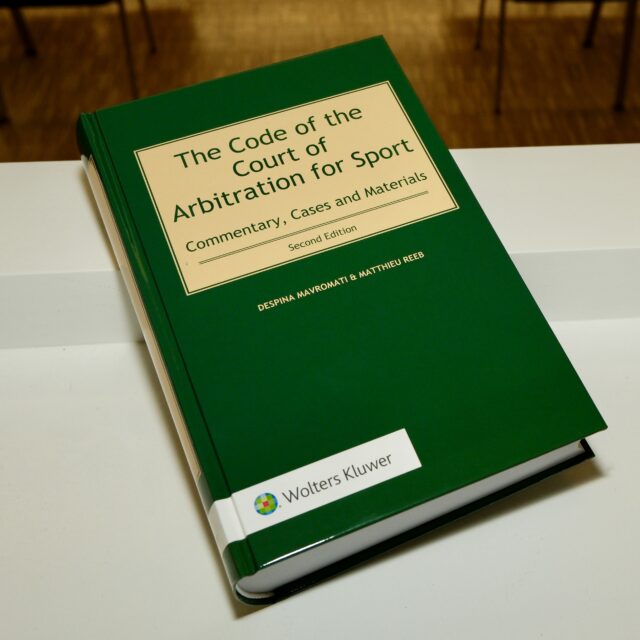Semenya v. Switzerland, Application no. 10934/21 / Judgment of the ECHR Grand Chamber of 10 July 2025
1. Facts & procedural history
Following the adoption, by World Athletics, of the “DSD Regulations”, South African champion Caster Semenya (Semenya, the Athlete) was excluded from international women’s middle-distance races unless she medically – or surgically – lowered her naturally high testosterone levels. The Athlete lost before the Court of Arbitration for Sport (CAS) in April 2019 and the Swiss Federal Supreme Court (SFT) in 2020 (see my note here) and subsequently filed an application against Switzerland with the European Court of Human Rights (ECHR). In July 2023, the ECHR issued its judgment (the First Semenya Judgment) considering that Switzerland had violated Articles 8, 13, and 14 (privacy, effective remedy, non-discrimination) and indirectly Article 6 (right to a fair hearing) of the European Convention on Human Rights (the Convention).
Switzerland subsequently referred the case to the ECHR Grand Chamber, whose final judgment was delivered on 10 July 2025 (the Grand Chamber Semenya Judgment). Below I address some key findings of this interesting judgment -but also what was left undecided and why – along with some takeaways and potential implications for the CAS and the SFT.
2. Main legal points addressed in the Grand Chamber Semenya Judgment
As will be shown in more detail below, the Grand Chamber departed from the findings of the First Semenya Judgment and considered that the SFT had no jurisdiction over the Athlete’s substantive grievances (based on Articles 8, 13 and 14) to the extent that she is a South African athlete and the International Federation (World Athletics) is based in Monaco. As such, all these substantive violations of the Convention alleged by the Athlete were left undecided by the Grand Chamber.
On the other side, the Grand Chamber found that Article 6 did apply, finding by fifteen votes to two that the Athlete had been deprived of her right to a fair hearing. Similar to the recent Seraing CJEU Judgment (albeit based on a different legal framework), the central point of the Grand Chamber’s analysis was the standard of effective judicial review of fundamental human rights when arbitration is compulsory: in so doing, the Grand Chamber included a large number of references to its own case law (Mutu & Pechstein v. Switzerland) but also to the case law of the CJEU, in particular the ISU Judgment (when it comes to the standard of effective judicial review of EU public policy provisions).
The Grand Chamber considered that the SFT, in the particular circumstances of the case (where fundamental civil rights of bodily integrity, dignity and discrimination are at stake) should have conducted a “particularly rigorous examination” instead of the narrow control through the public policy angle, which however is a well-established and longstanding practice of the SFT under Article 190 para. 2 (e) PILA.
3. Compulsory arbitration and effective judicial review: Another consequence of compulsory arbitration under Article 6 ECHR?
Similar to previous ECHR and CJEU judgments (Mutu & Pechstein v. Switzerland, ISU v. Commission, Seraing v. FIFA) the decisive argument for the Grand Chamber’s finding was the compulsory character of arbitration.
The Grand Chamber albeit recalled the numerous advantages of arbitration and, more specifically, sports arbitration (§ 195 ff.) but also the findings of its Mutu & Pechstein Judgment when it comes to the advantages of sports arbitration (“a specialized body which is able to give a ruling swiftly and inexpensively”, “recourse to a single and specialized international arbitral tribunal facilitates a certain procedural uniformity and strengthens legal certainty” § 199). However, the Grand Chamber also noted the regulatory character of (private) sports federations and the structural imbalance between sportspersons and sport governing bodies in the international sports arbitration system that would justify an enhanced review of the CAS awards by the SFT, which did not occur in this case. Among others, the Grand Chamber criticized the SFT for simply rejecting, without thoroughly examining, the Athlete’s arguments based on the SFT Matuzalem Judgment (the only judgment where the SFT accepted a violation of substantive public policy), even though both cases bore significant similarities (Grand Chamber Semenya Judgment, § 235).
Accordingly, in those cases where the athletes are compelled to bring their case to the CAS (compulsory arbitration), when fundamental civil rights are involved, the review by the SFT should be “particularly rigorous” as opposed to the very strict control within the realms of public policy shown by the SFT so far. The SFT will therefore need to impose higher scrutiny standars – again not for all CAS awards but for those cases involving compulsory arbitration and fundamental human rights.

3. What was left undecided and what happens next
As seen above, the substantive claims of Semenya, i.e. whether the DSD regulations themselves are discriminatory or violate privacy (Articles 8, 13 and 14), were left undecided by the Grand Chamber, considering that their substantive assessment was reserved for domestic or sports tribunals. The Grand Chamber thus (rightly, in my opinion) departed from the First Semenya Judgment on the extraterritorial aspects of the case and accepted that only the arbitration proceedings had taken place in Switzerland (hence the territorial link to Article 6, relating exclusively to procedural rights). Accordingly, neither the events in question (Athlete’s ineligibility following the DSD Regulations) took place in Switzerland nor the parties were Swiss residents or nationals, and Switzerland had no influence on the activities of World Athletics, itself based in Monaco (Grand Chamber Judgment, § 136 ff). Interestingly, the Grand Chamber differentiated this case from the Platini ECHR Judgment, where FIFA was based in Switzerland. Moreover, the compulsory arbitration argument raised by the Athlete was not sufficient to establish extraterritorial jurisdiction (§ 149).
The Grand Chamber further refused to review the Athlete’s claim based on Article 3 of the Convention to the extent that this was already found inadmissible in the First Semenya Judgment.
Another noteworthy element was that the claim questioning the independence of the CAS was also not reviewed by the Grand Chamber because the Athlete, in her application to the ECHR, had merely relied on Article 6 para. 1 and Article 13 of the Convention arguing a lack of effective remedy rather than a lack of access to an independent and impartial tribunal (Grand Chamber Semenya Judgment, § 87-89).
4. Concluding remarks
The case is not over, as it will return to the SFT which will conduct the “particularly vigorous review” of the CAS award as dictated by the Grand Chamber. The DSD will remain in force as the Grand Chamber did not invalidate them. Even if the SFT concludes that the CAS Panel violated public policy by not invalidating the DSD Regulations and finding violations of the Convention, the CAS award could be annulled but the DSD Regulations as such would not be automatically invalidated. Meanwhile, the World Athletics Council approved in March 2025 a reform of its eligibility framework, replacing the contested testosterone-suppression regime for DSD athletes with a one-time SRY gene test, applicable from 1 September 2025. The test, determines the Y chromosome and establishes a biological rather than a hormonal criterion for participation in the female category at world ranking competitions. Unlike the previous DSD Regulations, which required lowering the athletes’ testosterone levels in order to be eligible to compete, a positive SRY result excludes the athlete from elite female competition, irrespective of hormonal treatment. This regulatory change will likely have consequences for the broader legal debate between sporting fairness and fundamental rights.
It is undeniable that the Semenya Grand Chamber Judgment is important to the extent that it now reframes the level of judicial review in compulsory sports arbitration. Even though the Grand Chamber Semenya Judgment does not directly affect the CAS, the latter is still indirectly concerned in that it will be subject to a more robust judicial review of its awards by the SFT. It seems that athletes and other parties challenging rules on the basis of violation of fundamental human rights in compulsory arbitration proceedings will have the right of an extended review by the SFT, something that was denied .
The “particularly rigorous” examination expressed by the Grand Chamber will still need to be tested in practice: will it be more akin to the control of “arbitrariness” (a wider standard of review of manifestly unjustified decisions applicable to domestic arbitration only) or an even more thorough control of the Convention’s fundamental rights? The Grand Chamber criticised in particular the narrow scope of public policy according to the SFT, which is only violated if the consequences of the award (and therefore not the assessment of the arbitral tribunal) infringe public policy. Interestingly, pending the Semenya case before the Grand Chamber, the SFT showed reluctant to accept a direct application of the ECHR provisions – beyond the exhaustively enumerated grounds of Article 190 para. 2 PILA (see my note here). In any event, the SFT can still not be converted into an appellate tribunal or perform a de novo examination.
All in all, this new judgment is a welcome development to the extent that it raises the bar of review by the SFT but does not necessarily imply a further or significant delay of CAS awards or fragmentation of the centralized sports dispute resolution system by allowing claims in different fora (as the Seraing CJEU Judgment did).








